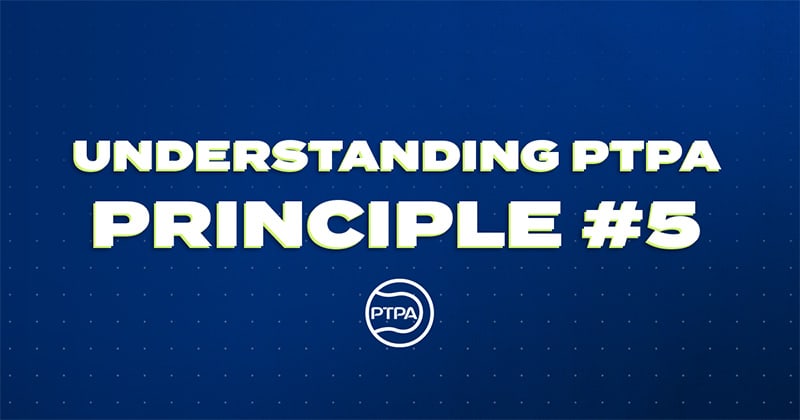
The fifth tenet of the PTPA Principles emphasizes how the Association is committed to “advocating for, and contributing to, the best vision and structure of tennis globally.” The PTPA is devoted to helping men’s and women’s players worldwide have a meaningful say and impact in shaping the future of tennis through collective action, especially in the tenet’s six sub-areas of focus: structure, innovation, the wildcard system, sustainability, evidence-based analyses, and event certification.
Principle 5a: Sport Structure
Tennis players should have a say on the structure of the sport (e.g.: scheduling), with mechanisms to enable them to collectively provide substantive input and contribute to its direction.
No stakeholder is more impacted by the structure of tennis than the players. Processes and decisions related to tournament scheduling, match scheduling, the length of tournaments and matches, the structure of the tour seasons, tournament curfews or lack thereof, and other fundamental elements of the sport’s structure meaningfully impact players’ day-to-day lives and their physical, mental and emotional wellbeing. Players must have a seat at the table when it comes to providing input on the existing structure of the sport, and should be encouraged and enabled to provide feedback on its evolution, with that feedback translating into action.
PTPA Principle – Sport Structure
Principle 5b: Innovation
Tennis players should have a say on innovation in the game with a player-first mindset (e.g.: rules changes, coaching, training, new technologies, etc.).
While tennis’ history and traditions are part of what makes the sport so special, tradition should be balanced with an openness toward changes that make the sport better. Innovative opportunities related to technology, rules, equipment, and other fundamental areas of the sport can help the game evolve and grow into the future, and further maximize its reach, relevance, revenue, and more. Traditionally, players have not had a meaningful say in which innovations are implemented and how they are implemented. Any and all changes to the game must be reviewed with a player-first mindset, and players should play a central role in providing feedback on proposed and implemented changes.
Principle 5c: Wildcard
Tennis players must have an established and transparent wildcard system.
Tennis’ wildcard system must be transparent and consistent across tournaments and players in order to protect the fairness of the sport. When wildcards are awarded entirely at the discretion of tournaments with little to no oversight and/or required explanations, then biases, favoritism, and inconsistency can creep into the process. Wildcards have an important place in tennis, but these decisions should be made according to clear, consistent, and player-approved guidelines.
PTPA Principle – Wildcard
Principle 5d: Sustainable
The PTPA is committed to the long-term economic sustainability and growth of the sport and its players.
The PTPA is devoted to working on behalf of the players to make professional tennis as sustainable as possible through consistent growth in its economics and visibility. Opportunities that may be appealing and profitable in the immediate short-term may not be beneficial for the longer-term evolution of the sport. Long-term stability and growth should be prioritized over short-term decisions that erode the ecosystem’s ability to maximize its revenues, opportunities, and reach. A focus on long-term stability and growth supports today’s players and generations of players to come.
Principle 5e: Evidence-Based
The PTPA is committed to conducting economic impact and analyses of the tennis industry and various proposals (CVC investment of WTA, ATP 30-year plan, etc.).
Tennis players must have access to evidence-based reviews of the current tennis industry and any newly-introduced proposals and investments. Unfortunately, when players are not privy to fact-based analyses and do not have a say in reviews processes surrounding new proposals, they are at risk for being used as pawns and subjected to conditions that they had no say in creating. Players must have access to unbiased analyses and mechanisms for providing collective feedback so they can play an active role in shaping the sport instead of being forced to deal with the repercussions of decisions that are imposed on them from above.
Principle 5f: Event Certification
The PTPA will explore certifying tournaments based on the precise requirements in order to recognize those that treat players properly and incentivize others to do the same.
Some tournaments are beloved by players thanks to their outstanding track records of respecting players’ rights and wellbeing and their consistency in providing players with state-of-the-art facilities, equipment, accommodations and other resources needed in order to train and compete at the highest levels. These events should be lauded and used as examples in creating events that truly put player health and wellbeing first. On the flip side, some tournaments have built far less favorable reputations with players, and are instead known for their disorganization, substandard facilities, and other challenges that negatively impact the players’ experiences year after year. These events must be held accountable and should be required and incentivized to make specific improvements to support player wellbeing. Event standards must exist, and must be enforced, to truly protect the athletes.
–
Collective action from players enables bargaining power that cannot be gained any other way. The PTPA is committed to providing independent, collective representation to players and empowering them to advocate for, and contribute to, the best vision and structure of tennis globally, as PTPA Principle tenet #5 states. The players are at the core of the sport, and must play an active role in providing feedback on its current state and shaping its future evolutions.
To learn more about the PTPA Principles, download the full Principles here, or read the breakdowns of the other four tenets here.